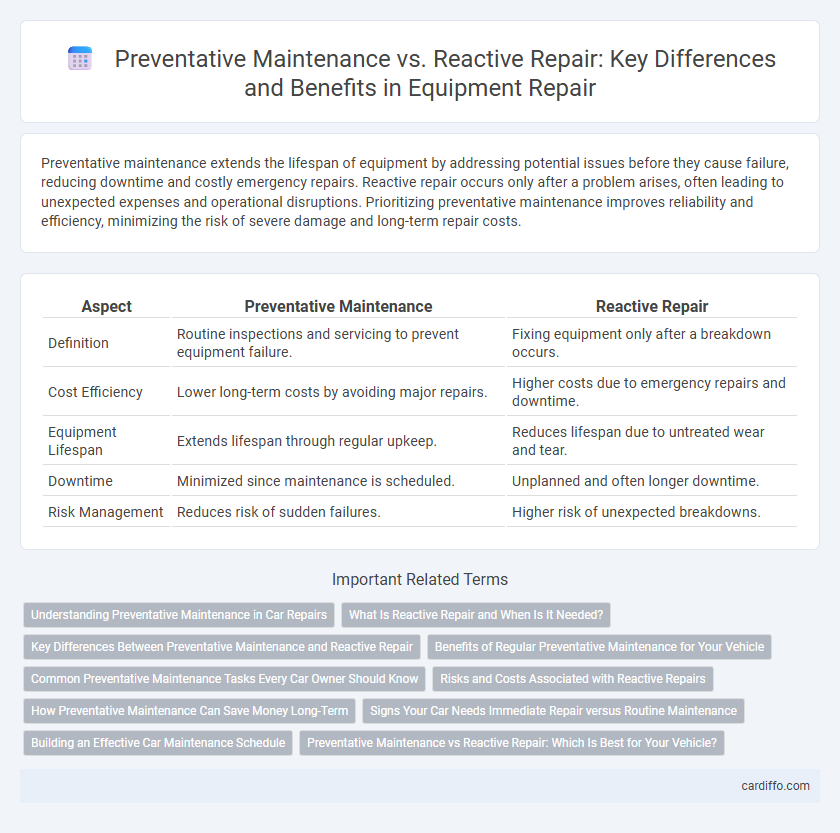Preventative maintenance extends the lifespan of equipment by addressing potential issues before they cause failure, reducing downtime and costly emergency repairs. Reactive repair occurs only after a problem arises, often leading to unexpected expenses and operational disruptions. Prioritizing preventative maintenance improves reliability and efficiency, minimizing the risk of severe damage and long-term repair costs.
Table of Comparison
| Aspect | Preventative Maintenance | Reactive Repair |
|---|---|---|
| Definition | Routine inspections and servicing to prevent equipment failure. | Fixing equipment only after a breakdown occurs. |
| Cost Efficiency | Lower long-term costs by avoiding major repairs. | Higher costs due to emergency repairs and downtime. |
| Equipment Lifespan | Extends lifespan through regular upkeep. | Reduces lifespan due to untreated wear and tear. |
| Downtime | Minimized since maintenance is scheduled. | Unplanned and often longer downtime. |
| Risk Management | Reduces risk of sudden failures. | Higher risk of unexpected breakdowns. |
Understanding Preventative Maintenance in Car Repairs
Preventative maintenance in car repairs involves scheduled inspections and servicing to identify and address potential issues before they cause breakdowns, ensuring vehicle reliability and longevity. This approach includes routine tasks like oil changes, brake checks, and tire rotations that reduce the risk of costly reactive repairs caused by unexpected failures. Regular preventative care improves engine performance, enhances safety, and lowers overall repair costs by minimizing emergency interventions.
What Is Reactive Repair and When Is It Needed?
Reactive repair is a maintenance approach that involves fixing equipment or systems after a failure or malfunction has occurred, rather than preventing issues before they arise. It is needed when unexpected breakdowns disrupt normal operations, requiring immediate attention to restore functionality and minimize downtime. This method can lead to higher costs and extended outages compared to preventative maintenance, but remains essential for addressing unforeseen problems and emergency situations.
Key Differences Between Preventative Maintenance and Reactive Repair
Preventative maintenance involves regularly scheduled inspections and servicing to avoid equipment failures, while reactive repair addresses problems only after a malfunction occurs. Key differences include cost efficiency, as preventative maintenance reduces unexpected downtime and long-term repair expenses, whereas reactive repair often leads to higher immediate costs and prolonged outages. Preventative maintenance enhances equipment lifespan and reliability; reactive repair focuses on fixing issues as they arise without planning, increasing the risk of severe damage.
Benefits of Regular Preventative Maintenance for Your Vehicle
Regular preventative maintenance enhances vehicle reliability by addressing potential issues before they lead to costly breakdowns, reducing the frequency of unexpected repairs. Scheduled oil changes, brake inspections, and fluid top-offs improve engine performance and extend the vehicle's lifespan. This proactive approach minimizes long-term repair expenses and ensures safer driving conditions.
Common Preventative Maintenance Tasks Every Car Owner Should Know
Regular oil changes, tire rotations, and brake inspections are essential preventative maintenance tasks that extend vehicle lifespan and improve safety. Checking fluid levels and replacing air filters help maintain engine efficiency and prevent costly repairs. Scheduling routine battery tests and alignment checks reduces the risk of unexpected breakdowns and enhances overall performance.
Risks and Costs Associated with Reactive Repairs
Reactive repairs often lead to higher costs due to unexpected equipment failures requiring immediate attention and emergency parts procurement. The risks of reactive repairs include extended downtime, reduced equipment lifespan, and potential safety hazards caused by unaddressed wear and tear. Preventative maintenance mitigates these risks by identifying issues early, thus minimizing expensive breakdowns and improving operational reliability.
How Preventative Maintenance Can Save Money Long-Term
Preventative maintenance reduces long-term expenses by identifying and addressing potential issues before they escalate into costly repairs or equipment failures. Regular inspections, lubrication, and part replacements extend asset lifespan and improve operational efficiency, minimizing downtime and emergency repair costs. Investing in scheduled maintenance programs ultimately lowers total maintenance costs by preventing major breakdowns and ensuring consistent performance.
Signs Your Car Needs Immediate Repair versus Routine Maintenance
Visible warning lights on the dashboard, unusual noises such as grinding or squealing, and fluid leaks under the vehicle are key signs your car requires immediate repair to avoid further damage. Routine maintenance includes scheduled oil changes, tire rotations, and brake inspections designed to prevent breakdowns and extend vehicle lifespan. Recognizing the difference between urgent repairs and planned maintenance helps ensure optimal performance and safety on the road.
Building an Effective Car Maintenance Schedule
Creating an effective car maintenance schedule hinges on prioritizing preventative maintenance, which systematically addresses potential issues before they escalate into costly repairs. Regular inspections of key components like brakes, tires, and fluids reduce the risk of breakdowns, extending vehicle lifespan and enhancing safety. Reactive repair, while necessary for unexpected failures, often incurs higher expenses and disrupts planned usage, underscoring the value of a consistent preventative approach.
Preventative Maintenance vs Reactive Repair: Which Is Best for Your Vehicle?
Preventative maintenance involves regularly scheduled inspections and services designed to identify and address potential issues before they become serious, enhancing vehicle longevity and performance. Reactive repair focuses on fixing problems only after a breakdown or malfunction occurs, often resulting in higher costs and longer downtime. Choosing preventative maintenance over reactive repair reduces unexpected failures and improves overall vehicle reliability.
Preventative maintenance vs reactive repair Infographic

 cardiffo.com
cardiffo.com